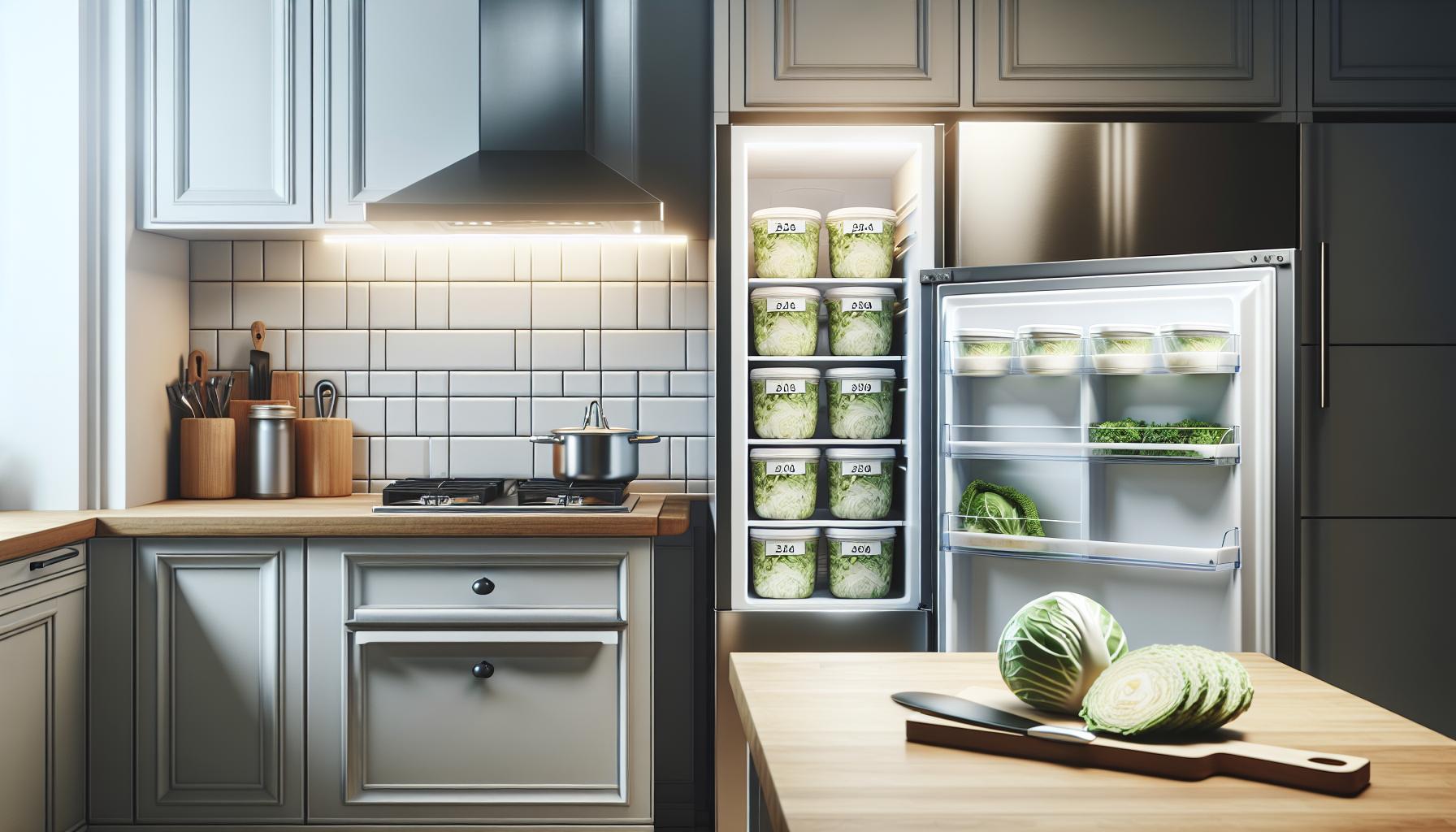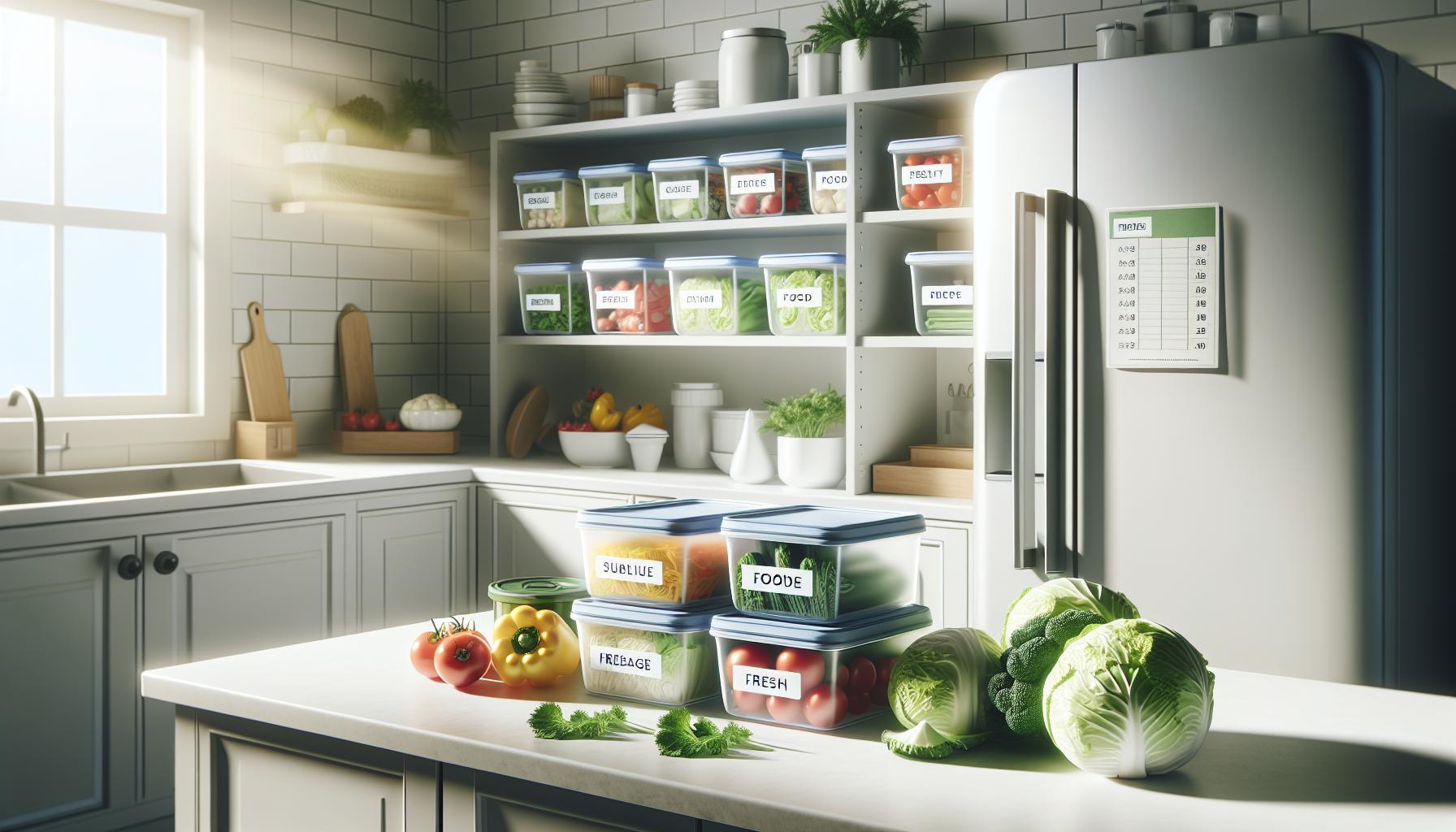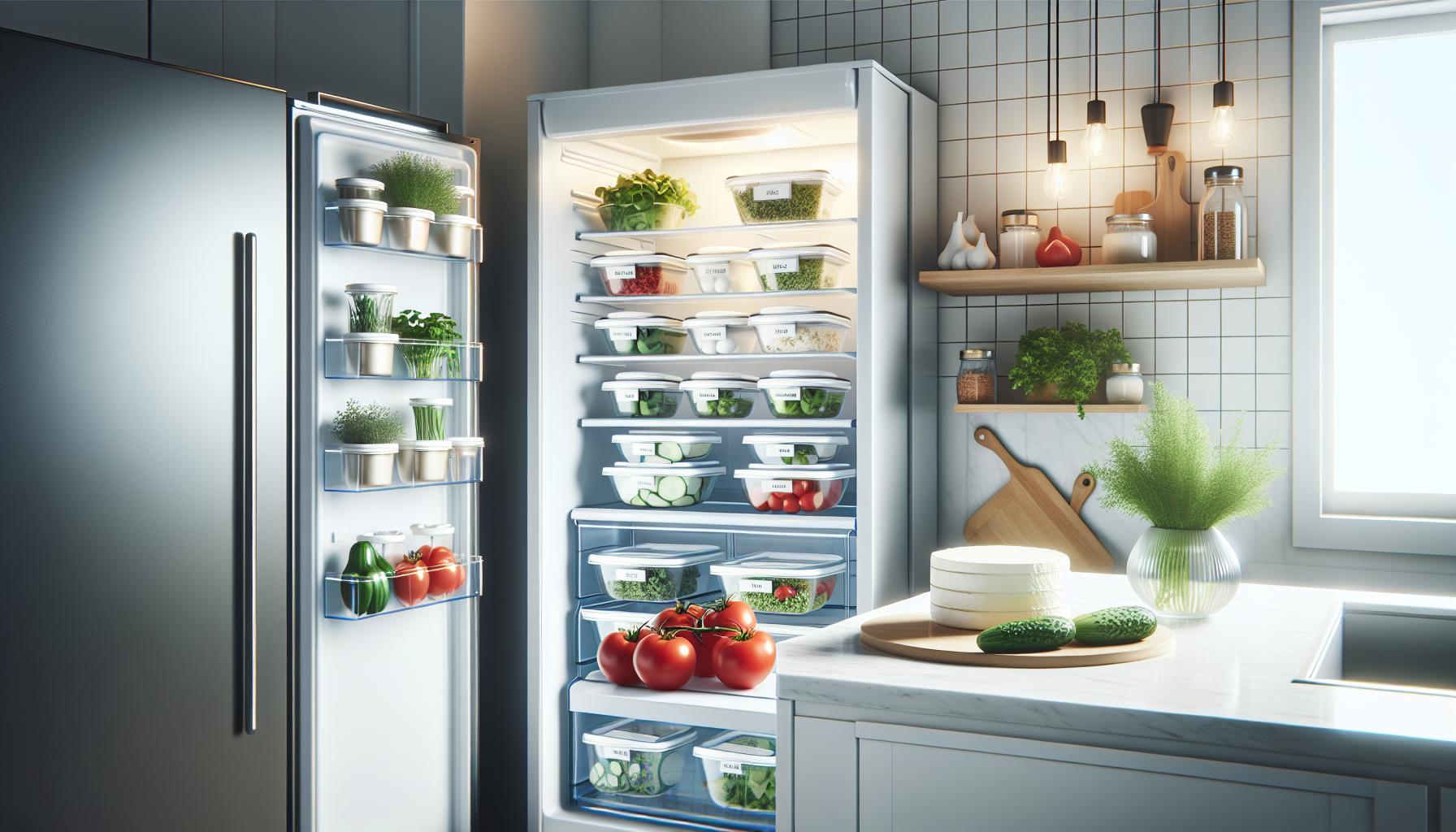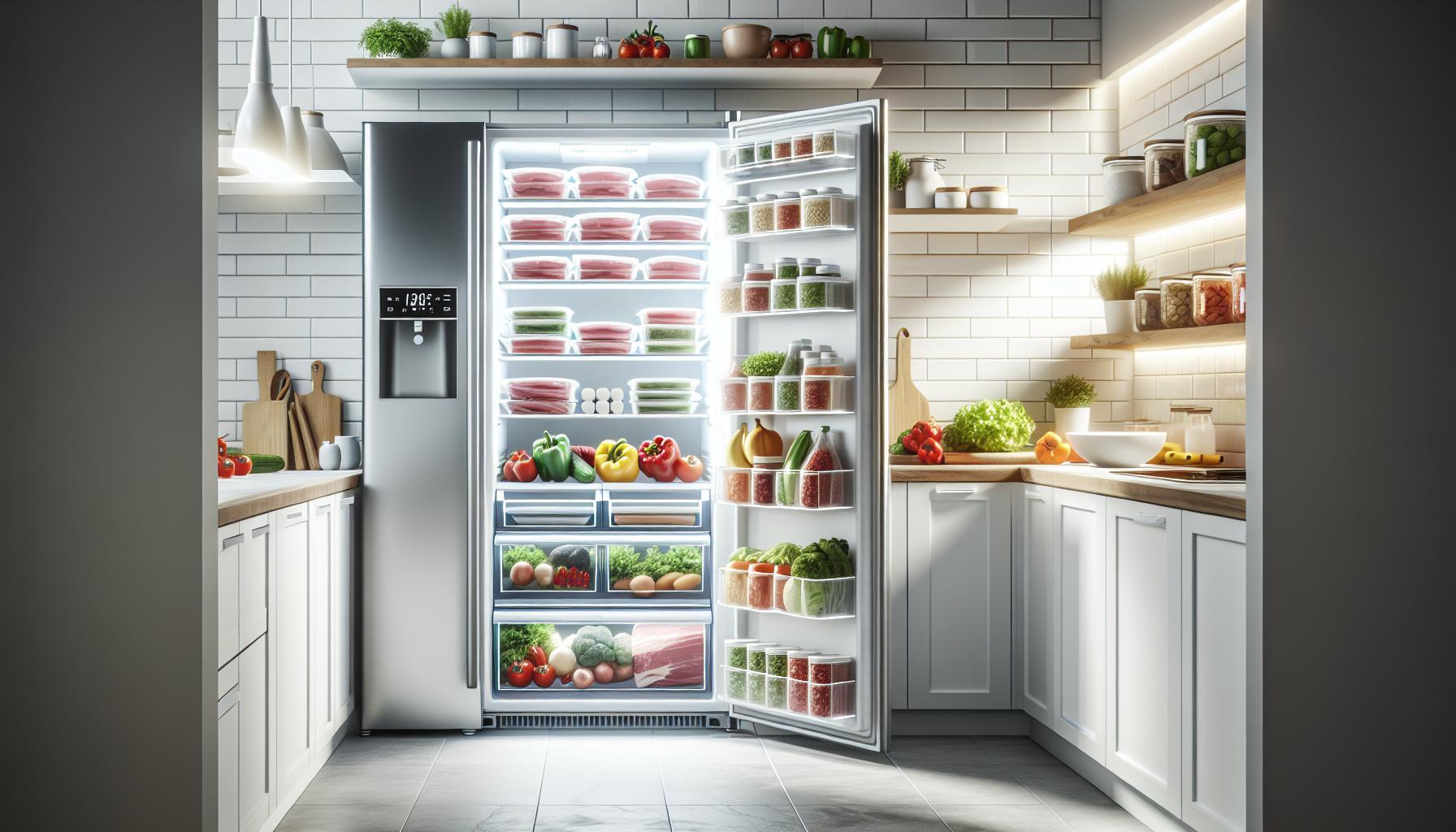Did you know that properly storing cooked cabbage can significantly extend its freshness and flavor? Leftover cabbage can make for an excellent addition to your meals, but understanding how long it lasts in the refrigerator is essential for your food safety and enjoyment. Many cooking enthusiasts face the dilemma of when to toss out leftovers, fearing potential spoilage or harmful bacteria.
In this guide, we’ll dive into the safe storage practices for cooked cabbage, exploring its shelf life, practical tips for keeping it fresh, and how to identify the signs of spoilage. By mastering these storage techniques, you can confidently enjoy your delicious cabbage dishes while minimizing waste and maximizing flavor. Stay with us to ensure that your culinary creations remain as delightful as the day they were made!
How Long Can Cooked Cabbage Stay Fresh?
Cooked cabbage, when properly stored, can remain fresh in the refrigerator for about 3 to 5 days. This timeframe ensures that you can enjoy its unique flavor and texture without the worry of spoilage impacting your meal. To maximize freshness, it’s vital to store the cabbage in an airtight container or tightly wrapped in plastic wrap. This helps minimize exposure to air, which can lead to faster deterioration.
To keep track of freshness, consider labeling the storage container with the date you cooked the cabbage. This way, you can easily see how many days it has been stored. Additionally, storing cooked cabbage on a shelf in the fridge rather than in the crisper drawer can help maintain its quality, as the temperature tends to be more consistent on the shelves.
When it comes to serving and using leftovers, always remember that observing proper refrigeration guidelines not only extends the life of your cooked cabbage but also ensures it remains safe to eat. If the cabbage is showing signs of spoilage-such as an off smell, discoloration, or a slimy texture-it’s best to err on the side of caution and discard it. Always prioritize safety and make informed decisions regarding food storage and consumption.
Understanding Cabbage Storage Guidelines
When it comes to food safety, understanding how to properly store cooked cabbage is crucial for maintaining its freshness and avoiding spoilage. Cooked cabbage is versatile and nutritious, making it a popular addition to meals. However, without the right storage practices, its quality can quickly diminish. To maximize the lifespan of cooked cabbage, it’s important to adhere to key storage guidelines that ensure both safety and quality.
To begin with, always allow the cooked cabbage to cool to room temperature before placing it in the refrigerator. This step helps prevent condensation inside the storage container, which can lead to a soggy texture and faster spoilage. Once cooled, transfer the cabbage into an airtight container or wrap it tightly in plastic wrap. This barrier not only keeps the moisture in but also protects against other odors or foods in the fridge that could alter its flavor.
Storage location within the refrigerator also plays a significant role in maintaining the cabbage’s quality. It’s advisable to store the cooked cabbage on a shelf, as it is often more consistently cold than the crisper drawer, which can experience slight temperature fluctuations. Additionally, labeling the storage container with the cooking date can help monitor its freshness more effectively, ensuring you consume it within the safe timeframe of 3 to 5 days.
This approach not only maximizes the enjoyment of your cooked cabbage but also contributes to preventing food waste. By being mindful of how you store your leftovers, you are not just protecting your health but also making a positive impact on your household’s sustainability efforts. Always remember, if at any point you detect unusual odors, discoloration, or a slimy texture, it’s best to err on the side of caution and discard the cabbage. Taking these necessary steps will ensure that you can safely enjoy your cooked cabbage for days to come.
Signs Your Cooked Cabbage Has Spoiled
When it comes to food safety, recognizing signs of spoilage in cooked cabbage is essential for your health and enjoyment. Cooked cabbage may not emit strong odors like some other food items, making it crucial to pay attention to its appearance and texture. Here are the key indicators that your cooked cabbage has gone bad:
- Unpleasant Odor: Fresh cooked cabbage has a mild, earthy scent. If it starts to smell sour, strong, or unusually pungent, it’s best to toss it.
- Discoloration: While slight changes in color might be expected over time, significant discoloration-such as brown or black spots-indicates spoilage.
- Texture Changes: Cooked cabbage should be tender but firm. A slimy or mushy texture suggests bacterial growth and spoilage.
- Mold Development: If you notice any fuzzy growths (green, black, or white mold), do not attempt to salvage it. Discard the cabbage immediately.
- Excessive Moisture: If there is a pool of liquid in the container, especially a sticky or viscous liquid, it could be a sign of microbial action. This excess moisture can foster bacteria and should be monitored closely.
Proper vigilance with these signs can prevent foodborne illnesses. Trust your senses-if anything about the cooked cabbage seems off, it’s better to be cautious and dispose of it. Following storage guidelines can help prolong its edibility, but being aware of these spoilage indicators is just as crucial for maintaining food safety. If storing cooked cabbage in the refrigerator, aim to consume it within 3 to 5 days to ensure it stays fresh and safe to eat.
Optimal Refrigerator Storage Tips for Cooked Cabbage
To keep your cooked cabbage fresh for as long as possible, proper refrigeration techniques are crucial. One of the most important steps involves promptly refrigerating the cabbage within two hours of cooking, as bacteria can grow rapidly at room temperature. Once cooled, transfer the cabbage into shallow airtight containers or wrap it securely with heavy-duty aluminum foil or plastic wrap. This method not only prevents contamination but also minimizes moisture loss, which can help maintain texture and flavor.
Maintaining a consistent refrigerator temperature at or below 40°F (4°C) is essential for food safety. For optimal freshness, aim to consume the cooked cabbage within 3 to 5 days. Beyond this timeframe, while it may still appear fine, the quality might deteriorate, potentially leading to spoilage indicators such as off-smells or textural changes. Always label your containers with the date of storage to easily keep track of their freshness and plan your meals accordingly.
Regularly check your stored cabbage for any signs of spoilage. Additionally, if you have a larger batch, consider portioning it into smaller servings before refrigerating, which not only facilitates quicker cooling but also allows for more flexibility when planning meals. By adopting these best practices, you can ensure that your cooked cabbage remains a delicious and safe addition to your meals throughout the week.
Extending Shelf Life: Best Practices
To maximize the longevity of your cooked cabbage while ensuring safety and flavor, implementing best practices in storage is essential. First and foremost, always refrigerate your cooked cabbage within two hours of cooking to minimize the risk of bacterial growth. The faster it cools down to a safe temperature, the better. Once you’re ready to store, opt for shallow airtight containers or sealable plastic bags; this aids in rapid cooling and helps prevent spoilage caused by exposure to air.
Labeling your containers with the date of storage is also a valuable habit. This small yet crucial step allows you to easily track how long the cabbage has been stored, ensuring you enjoy it while it’s still fresh. Be mindful of keeping your refrigerator at or below 40°F (4°C). Regularly checking your perishables can prevent them from lingering too long-aim to consume cooked cabbage within the recommended 3 to 5 days. If you notice any off-odors or changes in texture, it’s best to err on the side of caution and dispose of it.
- Portion control: Divide larger quantities of cooked cabbage into smaller servings before refrigerating. This facilitates quicker cooling and allows flexibility when meal planning, reducing the likelihood of waste.
- Moisture management: If you’re storing cabbage with sauces or dressings, be cautious as these may affect freshness and texture. Consider storing dressings separately to maintain quality.
- Keep it clean: Ensure that all containers and utensils are clean to prevent cross-contamination, preserving the integrity of your stored food.
By following these best practices, you can extend the shelf life of your cooked cabbage, ensuring it remains a safe and delightful addition to your meals for several days.
Freezing Cooked Cabbage: A Safe Option
Freezing cooked cabbage is an excellent method to preserve its freshness and nutritional value while extending its shelf life significantly. When properly frozen, cooked cabbage can maintain its best quality for about 10 to 12 months in the freezer. This makes it a great option for those who want to reduce food waste or prepare meals in advance. Preparing cooked cabbage for freezing requires a few simple steps to ensure that it retains its texture and flavor upon reheating.
Begin by allowing the cooked cabbage to cool completely. It’s best to spread it out on a baking sheet or a plate to quicken the cooling process. Once cooled, portion the cabbage into airtight freezer bags or containers. This not only makes it easier to thaw only what you need but also promotes even freezing, which can help preserve texture. For optimal storage, try to remove as much air as possible from the bags before sealing; this helps prevent freezer burn. It’s also a good practice to label your containers with the date of freezing so you can keep track of how long the cabbage has been stored.
When you’re ready to use your frozen cooked cabbage, the best practice is to thaw it in the refrigerator overnight before reheating. This slow thawing method helps maintain the vegetable’s quality and ensures safety. Alternatively, you can add frozen cooked cabbage directly to soups or stews without thawing, allowing it to heat through while cooking. If you’re using a microwave to reheat, do so at a low power setting to avoid overcooking, which can wilt the leaves and affect the texture.
By following these simple guidelines for freezing cooked cabbage, you can enjoy its delicious taste and health benefits at your convenience while minimizing waste and ensuring safety.
Reheating Cooked Cabbage Safely
Reheating cooked cabbage properly is essential to not only maintain its taste and texture but also to ensure food safety. When cabbage is cooked and then stored, bacteria can multiply if it’s not reheated adequately. The USDA recommends that all leftovers, including cooked cabbage, should be reheated to an internal temperature of at least 165°F (74°C) to kill any potential pathogens. This can be easily achieved with a food thermometer, which is an invaluable tool in the kitchen for ensuring your meals are safe to eat.
Methods of Reheating
There are several effective methods for reheating cabbage, each with its own benefits:
- Microwave: This method is quick and convenient. To reheat cabbage in the microwave, place the portion in a microwave-safe dish, adding a splash of water to create steam. Cover the dish loosely with a lid or microwave-safe plastic wrap. Heat on high for about 2-3 minutes, stirring halfway through, until heated evenly.
- Stovetop: For a more controlled reheating process, use a skillet. Heat a small amount of oil or butter in a pan over medium heat, then add the cabbage. Stir frequently for about 5-7 minutes, or until heated through. This method allows you to revive the flavors and add seasoning if desired.
- Oven: If you’re reheating a larger quantity, the oven is a great option. Preheat to 350°F (175°C), place the cabbage in an oven-safe dish, and cover it with foil to keep it moist. Heat for about 15-20 minutes, checking occasionally until it reaches the appropriate temperature.
Regardless of the method used, avoid reheating cabbage more than once. Repeated heating can lead to diminished quality and increased risks of foodborne illness. If you find you have a lot of leftovers, consider portioning them out before reheating to ensure you only warm what you need.
By following these guidelines, you can ensure that your reheated cabbage remains delicious and safe to eat, allowing you to enjoy its unique flavor and health benefits while minimizing food waste.
Nutritional Value of Cooked Cabbage Over Time
Cooked cabbage is not only a versatile ingredient but also a nutritional powerhouse that can retain many of its health benefits even after cooking. However, the nutritional value of cooked cabbage does decline over time due to factors such as storage conditions and duration. When cooked, cabbage is rich in vitamins C and K, dietary fiber, and antioxidants, which are vital for overall health. The cooking process can actually enhance certain nutrients, making them more bioavailable, while others may diminish slightly with prolonged storage.
To maximize nutritional value, it’s essential to consume cooked cabbage within a safe timeframe. Generally, cooked cabbage maintains optimal quality for about 3 to 5 days when stored in the refrigerator. As time goes on, there can be a gradual loss of vitamins, with vitamin C being particularly sensitive to heat and prolonged exposure to air and light. After the initial few days, while some nutrients remain, it’s prudent to prioritize fresh consumption for maximum health benefits.
Additionally, proper storage practices significantly influence how long cooked cabbage retains its nutrients. Storing it in airtight containers minimizes exposure to air, light, and moisture, which can accelerate nutrient degradation. If you’re looking to extend the shelf life further, freezing is a safe option; cooked cabbage can be frozen and preserved for 10 to 12 months without substantial loss of nutritional quality. However, freezing alters the texture, so it’s best suited for soups, stews, and casseroles.
In summary, understanding the balance between the longevity and nutritional value of cooked cabbage can help you make informed decisions about preserving and enjoying this healthful vegetable. Regularly assess leftovers and prioritize consumption within a safe timeframe to ensure you benefit from its nutritive properties while minimizing waste.
Common Myths About Cabbage Storage
Misunderstandings surrounding cabbage storage can lead to unnecessary food waste and safety concerns. One prevalent myth is that cabbage retains its freshness indefinitely when stored in the refrigerator. In reality, cooked cabbage should ideally be consumed within 3 to 5 days when properly stored in an airtight container. After this window, not only does its flavor diminish, but there is also an increased risk of spoilage, which can compromise food safety.
Another common misconception is that leaving cooked cabbage at room temperature for short periods is acceptable. Many individuals believe that if cooked cabbage looks and smells fine, it is safe to eat. However, food safety standards recommend keeping perishable foods, including cooked cabbage, out of the “danger zone” (40°F to 140°F), where harmful bacteria can multiply rapidly. Always refrigerate leftovers within two hours of cooking to mitigate this risk.
Furthermore, some people assume that cooking cabbage will kill all bacteria, making any leftover safe for extended periods. While cooking does kill many pathogens, it does not prevent contamination after cooking. Ensuring proper storage techniques post-cooking is crucial. This includes using containers that seal tightly and keeping the refrigerator at or below 40°F.
For those considering freezing cooked cabbage to extend its shelf life, there is often confusion about texture deterioration. While freezing can be an effective preservation method, it can alter the texture of the cabbage. This means that while frozen cabbage is safe for consumption up to 10 to 12 months, it is best suited for use in soups or casseroles rather than as a standalone dish.
By dispelling these myths and following guideline recommendations, you can ensure that your cooked cabbage remains safe to eat and retains its quality for longer periods. Understanding the facts around cabbage storage not only enhances food safety but also contributes to better meal planning and minimal waste.
Health Risks of Improperly Stored Cabbage
Improper storage of cooked cabbage can lead to various health risks, primarily due to the growth of harmful bacteria that thrive in the “danger zone” of temperatures between 40°F and 140°F. When cooked cabbage is left out at room temperature for more than two hours, the risk of pathogenic bacteria, such as Salmonella and Listeria, multiplying increases significantly. Consuming cabbage that has been improperly stored can lead to foodborne illnesses, which can cause symptoms like nausea, vomiting, diarrhea, and abdominal cramps.
In addition to bacterial contamination, the deterioration of cooked cabbage over time can lead to mold growth and spoilage. Mold can produce mycotoxins, which pose serious health risks if ingested. While cooking may eliminate some bacteria, it does not guarantee that cabbage will remain safe indefinitely. Once cooked, it’s essential to refrigerate leftover cabbage in airtight containers promptly to minimize risks. Stored properly, cooked cabbage can last safely for about 3 to 5 days; beyond that period, the chances of spoilage dramatically increase.
To maintain food safety, always check for signs of spoilage before consumption. If cooked cabbage exhibits an off-smell, unusual texture, or any discoloration, it’s best to discard it rather than risk illness. The fundamental principle is that when in doubt, throw it out. Understanding these risks will empower home cooks to handle leftovers safely, ensuring not only delicious meals but also the well-being of those they feed.
Here are some key practices to ensure safe storage:
- Refrigerate promptly: Cool cooked cabbage to room temperature and refrigerate within two hours.
- Use airtight containers: Store cabbage in shallow, airtight containers to limit exposure to air.
- Monitor refrigeration temperature: Keep your refrigerator at or below 40°F.
- Check expiration: Consume leftovers within 3 to 5 days to maintain quality and safety.
These strategies not only minimize health risks but also enhance food quality, ensuring your dishes remain tasty and safe to eat.
Creative Ways to Use Leftover Cooked Cabbage
Leftover cooked cabbage can be a culinary treasure if you know how to use it creatively. Not only does it reduce waste, but it also adds nutritious value to various dishes. Consider transforming that leftover cabbage into a hearty coleslaw by simply chopping it finely and mixing it with a tangy dressing of mayonnaise, vinegar, and spices. This crunchy side dish pairs beautifully with grilled meats and sandwiches.
Another fantastic option is to incorporate the cabbage into soups and stews. Simply add the cooked cabbage to a pot of vegetable or chicken stock, along with other vegetables like carrots and potatoes, and let it simmer to meld the flavors together. This not only enhances the dish’s depth but also adds a delightful texture.
You can also repurpose cooked cabbage in stir-fries. Toss it in with some sautéed onions, bell peppers, and your choice of protein, such as chicken or tofu, for a quick, nutritious meal. The cabbage can absorb the rich flavors of your sauce while maintaining its delightful crunch.
For a more creative twist, consider making stuffed cabbage rolls. Mix the cooked cabbage with rice, meat, or beans, roll it up, and bake in a tomato sauce until heated through. This dish makes for a delicious, comforting meal that can easily be reheated as needed.
Finally, don’t overlook the possibility of incorporating leftover cabbage into casseroles or breakfast dishes like frittatas. Adding it to scrambled eggs or baked egg dishes not only adds fiber but also enhances flavor, making for a satisfying start to your day. By using these ideas, you can ensure your cooked cabbage is utilized fully, enhancing both flavor and nutrition in your meals.
FAQ
Q: How can I tell if cooked cabbage has gone bad?
A: Signs that cooked cabbage has spoiled include an off smell, discoloration, and a slimy texture. If any of these signs are present, it’s best to discard the cabbage to avoid foodborne illness.
Q: Can you eat cooked cabbage that has been in the fridge for more than a week?
A: No, it is recommended to consume cooked cabbage within 3 to 5 days when stored in the refrigerator. Beyond that, the risk of spoilage increases, which could lead to food safety issues.
Q: What is the best way to store cooked cabbage in the refrigerator?
A: Store cooked cabbage in an airtight container to minimize exposure to air and moisture. This helps maintain freshness and prevents cross-contamination with other foods.
Q: Can cooked cabbage be reheated more than once?
A: It’s best to reheat cooked cabbage only once. Repeated heating can lead to spoilage and increase the risk of foodborne illness. Always ensure it is heated to at least 165°F (74°C) before consuming.
Q: Is it safe to freeze cooked cabbage?
A: Yes, cooked cabbage can be safely frozen. Ensure it is cooled completely, then place it in a freezer-safe container or bag. Properly stored, it can last about 10-12 months in the freezer without significant loss of quality.
Q: How long can cooked cabbage sit out at room temperature?
A: Cooked cabbage should not be left out at room temperature for more than 2 hours. Beyond this time, bacterial growth can increase the risk of foodborne illness.
Q: What should I do with leftover cooked cabbage?
A: You can store leftover cooked cabbage in the refrigerator or freezer, incorporate it into soups or stir-fries, or use it as a topping for salads to minimize food waste.
Q: Can I use leftover cooked cabbage in salads?
A: Yes, leftover cooked cabbage can be added to salads for extra flavor and nutrition. Just ensure it has been properly stored and is still fresh before adding it to your meal.
The Way Forward
Thank you for exploring how long cooked cabbage lasts in the refrigerator. Remember, for optimal freshness and safety, it’s best consumed within 3-5 days. If you’re storing it, make sure to keep it in an airtight container to prevent spoilage. For more tips on food storage safety, check out our guides on “Food Storage Best Practices” and “How to Identify Spoiled Vegetables” to optimize your kitchen management.
Feeling inspired to further enhance your cooking skills? Don’t forget to subscribe for more helpful food storage tips, and leave your questions or comments below! Share this with fellow cabbage lovers and help spread the word about safe food practices. Your next cooking adventure starts now, explore our recipe section for delicious ideas that utilize cabbage and other seasonal veggies!





